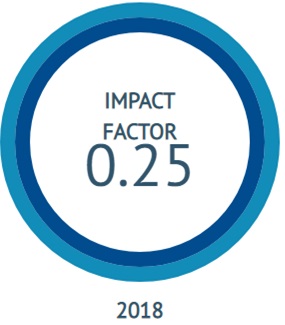Validation of Analytical Method Determination of Sodium Dodecyl Benzene Sulfonate (DBS) in Catfish (Clarias batrachus L.) by Spectrophotometric Using Methylene Blue
Abstract
A spectrophotometric method for analysis of DBS anionic surfactant in Clarias batracus has been validated. The method of analysis was divided into two phases. Extraction with solid-liquid extraction using Soxhlet and analysis of DBS. The extraction was performed using solvent of n-hexane and methanol for 9 and 6 hours, respectively. The analysis was performed using Spectrophotometer UV-Vis based on the complex formation of DBS-methylene blue (DBS-MB). This methods is applied to the determination of DBS in local catfish after DBS exposure and that of obtained in markets. The results showed that the parameters of validation methods have high acceptability as linierity (R2 = 0.99), limit of detection (LOD) and limit of quantification (LOQ ) (2.93 mg/g and 9.75 mg/g), sensitivity (ε = 2.44 x 105 L mol-1 cm-1), precision (RSD = 0.14-1.38%) and accuracy (% recovery in a range 82-110 %). The results of analysis of DBS in catfish with 2.5; 5; 10; 15 mg/L of DBS concentration exposure are 0.87; 1.67; 8.50 and 18.10 mg/kg, respectively and catfish from markets in a range 8.5-61 mg/kg. The result showed that the method of analysis of DBS anionic surfactant using MB could be applied for catfish samples.
Keywords: Validation methode, extraction, catfish, Clarias batrachus, dodecyl benzene sulfonate, methylene blue.
Downloads
References
2. Chitikela S, Dentel SK, Allen HE. Modified method for the analysis of anionic surfactants as Methylene Blue active substances. A. 1995;120(7):2001. doi:10.1039/an9952002001
3. González AG, Herrador MÁ, Asuero AG. Intra-laboratory assessment of method accuracy (trueness and precision) by using validation standards. T. 2010;82(5):1995-1998. doi:10.1016/j.talanta.2010.07.071
4. Jurado E, Fernández-Serrano M, Núñez-Olea J, Luzón G, Lechuga M. Simplified spectrophotometric method using methylene blue for determining anionic surfactants: Applications to the study of primary biodegradation in aerobic screening tests. C. 2006;65(2):278-285. doi:10.1016/j.chemosphere.2006.02.044
5. KOGA M, YAMAMICHI Y, NOMOTO Y, IRIE M, TANIMURA T, YOSHINAGA T. Rapid Determination of Anionic Surfactants by Improved Spectrophotometric Method Using Methylene Blue. A. 1999;15(6):563-568. doi:10.2116/analsci.15.563
6. León VM, López C, Lara-Martín PA, Prats D, Varó P, González-Mazo E. Removal of linear alkylbenzene sulfonates and their degradation intermediates at low temperatures during activated sludge treatment. C. 2006;64(7):1157-1166. doi:10.1016/j.chemosphere.2005.11.045
7. Olkowska E, Polkowska Ż, Namieśnik J. Analytical procedures for the determination of surfactants in environmental samples. T. 2012;88:1-13. doi:10.1016/j.talanta.2011.10.034
8. Otzen D. Protein–surfactant interactions: A tale of many states. B. 2011;1814(5):562-591. doi:10.1016/j.bbapap.2011.03.003
9. Sáez M, León V., Gómez-Parra A, González-Mazo E. Extraction and isolation of linear alkylbenzene sulfonates and their intermediate metabolites from various marine organisms. J. 2000;889(1-2):99-104. doi:10.1016/s0021-9673(00)00204-1
10. Versteeg DJ, Rawlings JM. Bioconcentration and Toxicity of Dodecylbenzene Sulfonate (C 12 LAS) to Aquatic Organisms Exposed in Experimental Streams. A. 2003;44(2):237-246. doi:10.1007/s00244-002-2017-2
Copyright (c) 2018 Journal of Applied Chemical Sciences

This work is licensed under a Creative Commons Attribution-NonCommercial-ShareAlike 4.0 International License.

 Christiani Dewi Q. M. Bulin(1*)
Christiani Dewi Q. M. Bulin(1*)










